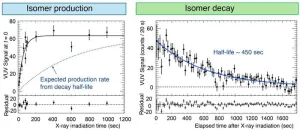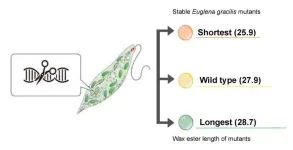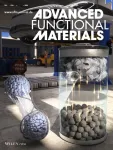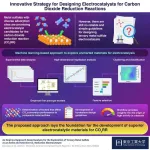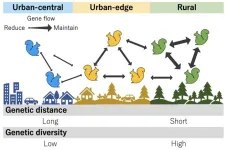(Press-News.org)
Scientists use atomic clocks to measure ‘second,’ the smallest standard unit of time, with great precision. These clocks use natural oscillations of electrons in atoms, similar to how pendulums work in old grandfather clocks. The quest for an even more precise timekeeper led to the discovery of nuclear clocks, which use the transitions of atomic nuclei instead of electrons to keep time.
A rising contender for the development of ultra-precise nuclear optical clocks is the nuclear first-excited state of 229Th isotope. Its long half-life of 103 seconds and low excitation energy of a few electron volts make it ideal for excitation by VUV lasers, providing a precise reference transition for nuclear clocks. Besides, nuclear clocks can also be used in compact solid-state metrology devices and fundamental physics research. To explore the potential application of 229Th isomer, it is essential to understand its fundamental properties like isomeric energy, half-life, and the dynamics of excitation and decay in detail.
Working in this direction, Assistant Professor Takahiro Hiraki from Okayama University, Japan and his team including Akihiro Yoshimi and Koji Yoshimura have developed an experimental setup to effectively assess the population of the 229Th isomeric state and detect its radiative decay. In their recent study published in Nature Communications on 16 July 2024, they synthesized 229Th-doped VUV transparent CaF2 crystals and demonstrated their ability to control 229Th isomeric state population using X-rays. “Our group is working on fundamental physics using atoms and lasers. To realize a solid-state nuclear clock using 229Th, it is necessary to control the excitation and de-excitation state of the nucleus. In this study, we successfully controlled the nuclear states using X-rays, bringing us one step closer to building a nuclear clock,” stated Assistant Professor Hiraki while explaining the motivation behind their study.
To investigate the radiative decay (de-excitation), the team created excitation from the ground state of 229Th nucleus to an isomer state, via the second excited state using a resonant X-ray beam. They found that the doped 229Th nucleus underwent radiative decay back to the ground state, along with the emission of a VUV photon.
One of the key findings was the rapid decay of the isomer state when exposed to X-ray beam irradiation and the “X-ray quenching” effect, which allowed de-population of the isomer on demand. The researchers believe that this controlled quenching could advance nuclear clock development, alongside other potential applications, such as portable gravity sensors and higher precision GPS systems.
Emphasizing the potential of nuclear optical clocks, Assistant Professor Hiraki says, “When the nuclear clock under development is completed, it will enable us to test whether ‘physical constants,’ especially fine structure constant, which were previously believed to remain unchanged, might vary over time. If time variation of physical constants is observed, it may lead to the elucidation of dark energy, one of the greatest mysteries of the universe.”
About Okayama University, Japan
As one of the leading universities in Japan, Okayama University aims to create and establish a new paradigm for the sustainable development of the world. Okayama University offers a wide range of academic fields, which become the basis of the integrated graduate schools. This not only allows us to conduct the most advanced and up-to-date research, but also provides an enriching educational experience.
Website: https://www.okayama-u.ac.jp/index_e.html
About Assistant Professor Takahiro Hiraki from Okayama University, Japan
Dr. Takahiro Hiraki is an Assistant Professor at Research Institute for Interdisciplinary Science at Okayama University, Japan. In 2012, he completed his Master’s and then went on to pursue his doctoral course at Department of Physics and Astrophysics, Kyoto University. He is a member of The Physical Society of Japan and The Japanese Society for Synchrotron Radiation Research. Over the course of his research career, he has published more than 60 papers and received over 7,300 citations. His current areas of interest include thorium laser atomic nucleus, atomic physics, elementary particles, and muons.
END
In a new study by the Potsdam Institute for Climate Impact Research (PIK), researchers analysed how erratic weather events, increasingly intensified by global warming, affect global production and consumption across different income groups. The results confirm previous studies that the poorest people worldwide bear the greatest economic risks from climate change. Surprisingly, the risk for the wealthy is growing the fastest. Economies in transition like Brazil or China are also highly vulnerable to severe impacts and negative trade ...
News about biofuels sometimes mentions used cooking oil as a feedstock, but if these substances contain animal fat, they can solidify in colder temperatures. This happens because, chemically, the fatty acids of these and many other saturated fats have long carbon chains with single bonds. Enter the euglena. An Osaka Metropolitan University team has found a way to have one species of this microalgae produce wax esters with shorter carbon chains than usual.
Using CRISPR/Cas9 to edit the genome of Euglena gracilis, Dr. Masami Nakazawa and her team at the Graduate School of Agriculture’s ...
A team led by Dr. Hyeon-Gyun Im and Dr. Dong Jun Kang from the Insulation Materials Research Center of Korea Electrotechnology Research Institute (KERI), in collaboration with Dr. Jung-keun Yoo from KIST and Professor Jong-soon Kim from Sungkyunkwan University, have developed a technology that enhances the performance of binders—often the 'unsung heroes' in the field of secondary batteries—while using environmentally friendly materials. This technology has been published in a prestigious international ...
CHICAGO (Sept 13, 2024)—Menopause is a natural life transition occurring when many women are at the “top of their game.” Unsupported menopause symptoms drive up employer healthcare costs and cause roughly $1.8 billion in missed workdays. To help employers retain these valued workers and build cultures of well-being, The Menopause Society launched Making Menopause Work™ based on new science-based Consensus Recommendations. The Recommendations are published online in Menopause, the journal of The Menopause ...
One of the most promising avenues for actively reducing CO2 levels in the atmosphere is recycling it into valuable chemicals via electrocatalytic CO2 reduction reactions. With a suitable electrocatalyst, this can be achieved under mild conditions and at a low energy cost. Many types of electrocatalysts are being actively investigated, but most suffer from either low electrocatalytic activity, poor selectivity, or low stability.
Metal sulfides might hold the huge potential solution to this puzzle. By combining ionic and covalent characteristics, this unique family of materials offers good catalytic activity and energy efficiency. The ternary metal system is expected to be a better ...
Kumamoto University’s research team, led by Assistant Professor Kazuto Hatakeyama and Professor Shintaro Ida of Institute of Industrial Nanomaterials, has announced a groundbreaking development in hydrogen ion barrier films using graphene oxide (GO) that lacks internal pores. This innovative approach promises significant advancements in protective coatings for various applications.
In their study, the research team successfully synthesized and developed a thin film from a new form of graphene oxide that does not contain pores. Traditionally, ...
Since many kinds of wildlife have started living in urban environments, urban environments have been recognized as places of biodiversity conservation. What kind of factors facilitate or prohibit wildlife from living in urban environments? Understanding the population genetic structure of urban wildlife living would suggest the hint. In this study, we investigated the population genetic structure of Eurasian red squirrels living in urban to rural areas in Obihiro City, Hokkaido, Japan. As a result, we found that ...
Interim data from the Phase I dose escalation part of the mRNA cancer immunotherapy (mRNA-4359), show promise in patients with advanced solid cancers.
The investigational mRNA cancer immunotherapy is targeted for patients with lung cancer, melanoma and other solid tumours. Nineteen patients with advanced stage cancers received between one and nine doses of the immunotherapy treatment. Scientists have found the immunotherapy created an immune response against cancer and was well tolerated, with adverse events ...
(Jackson, Wyoming – Embargoed until Thursday 12 September 2024 8:00 PM EDT)
A highly accurate diagnostic blood test has been developed for amyotrophic lateral sclerosis (ALS), a progressive neurodegenerative disease that effects neurons in the brain and spinal cord.
ALS leads to gradual paralysis, ultimately resulting in the inability to walk, speak, or, in later stages, move. Currently, diagnosis is based on a thorough clinical examination, but it can take up to 12 months to provide a definitive diagnosis, by which time many patients have significantly ...
Without immediate action, humanity will potentially face further escalation in resistance in fungal disease, a renowned group of scientists from the across the world has warned. The commentary - published in The Lancet this week - was coordinated by scientists at The University of Manchester, the Westerdijk Institute and the University of Amsterdam. According to the scientists most fungal pathogens identified by the World Health Organisation - accounting for around 3.8 million deaths a year - are either already resistant or rapidly acquiring resistance to antifungal drugs.
The authors argue that the currently narrow focus on bacteria will not fully combat antimicrobial resistance ...
